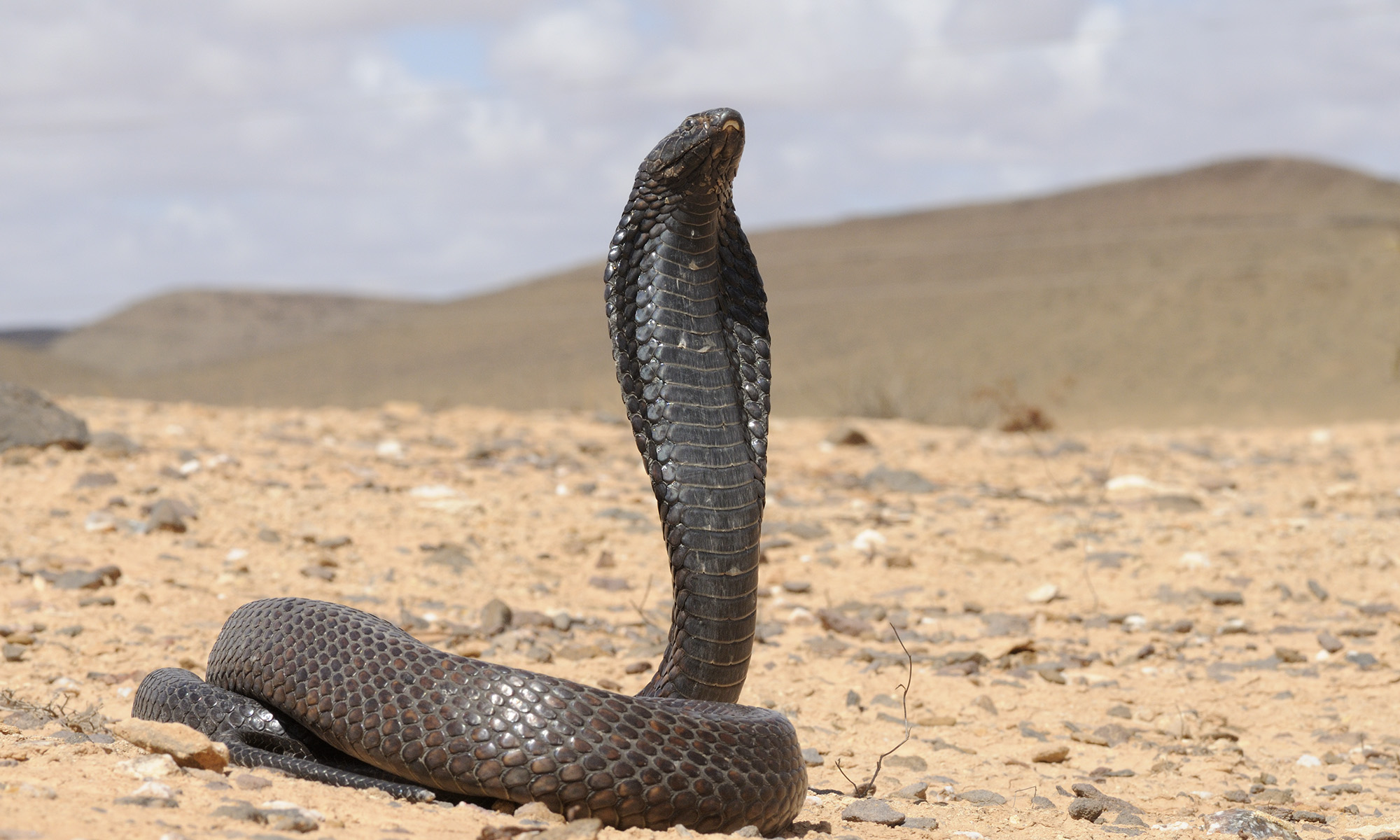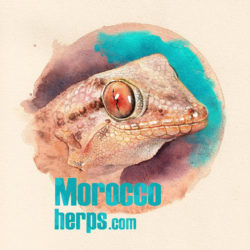Awl-headed Snake
Lytorhynchus diadema (Duméril, Bibron & Duméril, 1854)
By Gabriel Martínez del Mármol Marín
Updated: 23/02/2015
Taxonomy: Serpentes | Colubridae | Lytorhynchus | Lytorhynchus diadema
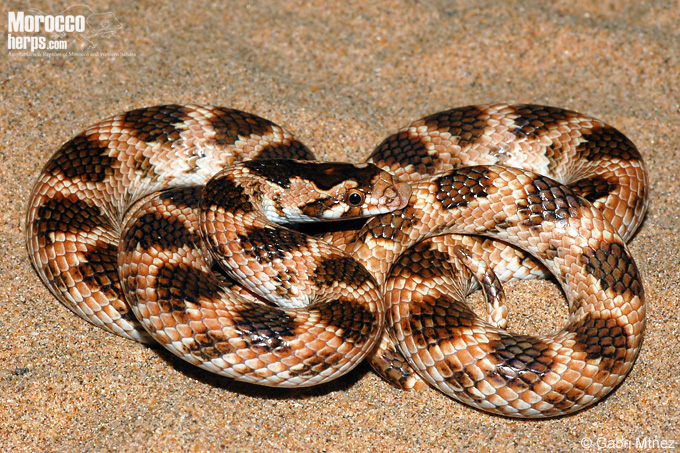
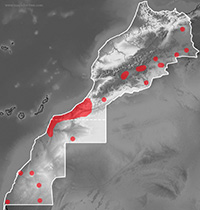
 Lytorhynchus diadema
Lytorhynchus diadema
Distribution map of
Lytorhynchus diadema
in Morocco.
Gallery: 3 photos. [ENTER]
Phylogenetic frame
Although the phylogenetic relationships within Lytorhynchus Peters, 1862 based on DNA sequences are not known yet, of the six recognized species in the genus Lytorhynchus, Lytorhynchus diadema is the most widely distributed and a great genetic variability could be expected.
It´s represented in Morocco by the nominal subspecies (Bons & Geniez, 1996).
Description
It´s a small sixed snake with 30-40cm, maximum 45cm (Schleich et al., 1996; Trape & Mané, 2006).
The head is ovaled, slightly distinct from neck. It has medium sized eyes with round pupil. The rostral scale is the best distinctive of this snake, large, projecting and very development, adapted to burrow habits. One or two preoculars (rarely three; Schleich et al., 1996). 7-8 supralabials, the 5 usually in contact with the eye, sometimes the 4 and 5 (Schleich et al., 1996; Trape & Mané, 2006).
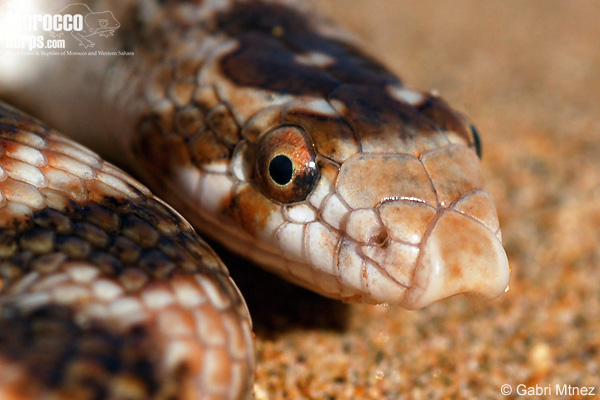
The body is cylindrical, with 19 rows of smooth scales at midbody. It has between 155-195 ventral scales, 33-47 subcaudal scales (paired). Anal divided. Tail relatively short (Schleich et al., 1996; Trape & Mané, 2006).
The back-ground coloration is variable, from cream to orange and redish brown, usually with sand coloration. It has a dark mark in the head in form of circle or similar form with sometimes a mark inside of the back-ground coloration. It also has an oblique bar on each side of the head passing below and behind eyes. In the dorsal area with dark marks in form of rectangle or romb, smaller in the flanks, all of them interspersed with light trasverse marks. Ventral area of uniform clear coloration.
Ecology and habits
Mainly crepuscular and nocturnal species (Trape & Mané, 2006; pers. Obs.), although it has been observed basking during morning (Schleich et al., 1996).
In some Algeria places realize a strict hibernation (Schleich et al., 1996). In Morocco coastal places must have a lower activity during the cold months and in the rest of its distribution could realize a diapause.
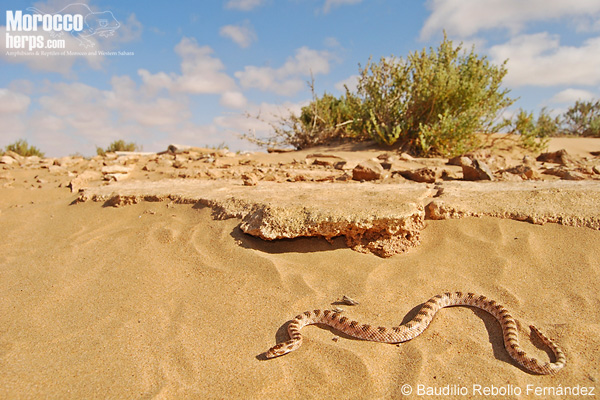
There isn´t information about sexuality in this species. But bigger movements of adult individuals have been seen in april-may so this could be the mating season.
It´s a very adapted burrower that look for preys in the sand. The known preys are in genus Tarentola, Acanthodactylus, Mesalina, Psammodromus, Stenodactylus and Chalcides. Sometimes also eats in small mammals and arthropods (Schleich et al., 1996).
Distribution, habitat and abundance
In Morocco and Western Sahara the species is known from some areas of the Saharan areas and punctually in arid areas (Bons & Geniez, 1996; Geniez et al., 2004).
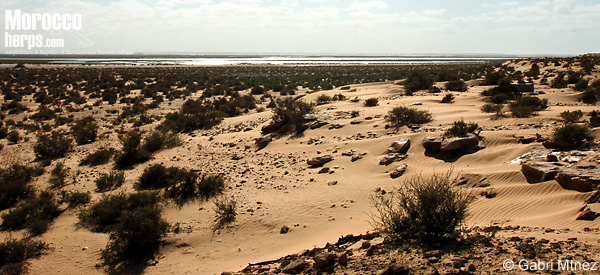
Although it´s also found in stony areas and bord of oueds, it´s more common in sandy areas like coastal dunes or sand banks (Bons & Geniez, 1996; Geniez et al., 2004).
It´s locally abundant in sand areas like coastal sand areas close Tarfaya and are not known specific problems in this species, considered at low risk of extinction (Little risk/less concern; LR-lc; Geniez et al., 2004).
References
- Baha el Din, S. 2006. A Guide to the Reptiles and Amphibians of Egypt. The American Unviersity in Cairo Press. Cairo-New York. 359 pp.
- Bons, J. y Geniez, P. 1996. Amphibiens et reptiles du Maroc (Sahara Occidental compris). Atlas Biogéographique. Asociacion Herpetologica Espanola, Barcelone. 319 pp.
- Geniez, P.; Mateo, J.A.; Geniez, M. y Pether, J. 2004. The amphibians and reptiles of the Western Sahara (former Spanish Sahara) and adjacent regions. Edition Chimaira, Frankfurt, 228 pp.
- Jablonski, D., Frynta, D., Martínez del Mármol Marín, G. 2014. New records of the Awl-headed Snake (Lytorhynchus diadema) from northeastern Morocco. Herpetology Notes 7: 295-297.
- Mediani, M., Fahd, S., Chevalier, F., Brito, J.C. 2015. Another record of Lytorhynchus diadema (Duméril, Bibron & Duméril, 1854) from Moroccan Atlantic Sahara. Herpetozoa 27 (3/4): 197-200.
- Schleich, H. H., Kastle, W., and Kabisch, K. 1996. Amphibians and Reptiles of North Africa. Koeltz Scientific Publishers, Koenigstein. 630 pp.
- Sochurek,E. 1979. Die Schlangen Nordafrikas. Mitt. Zool. Ges. Braunau 3 (8/9): 219-226
- Trape, J.-F. y Mané, Y. 2006. Guide des serpents d’Afrique occidentale. Savane et désert. IRD Editions, Paris, 226 pp.
To cite this page:
Gabriel Martínez del Mármol Marín (2015): Lytorhynchus diadema (Duméril, Bibron & Duméril, 1854). In: Martínez, G., León, R., Jiménez-Robles, O., González De la Vega, J. P., Gabari, V., Rebollo, B., Sánchez-Tójar, A., Fernández-Cardenete, J. R., Gállego, J. (Eds.). Moroccoherps. Amphibians and Reptiles of Morocco and Western Sahara. Available from www.moroccoherps.com/en/ficha/Lytorhynchus_diadema/. Version 23/02/2015.
To cite www.morocoherps.com en as a whole:
Martínez, G., León, R., Jiménez-Robles, O., González De la Vega, J.P., Gabari, V., Rebollo, B., Sánchez-Tójar, A., Fernández-Cardenete, J.R., Gállego, J. (Eds.). Moroccoherps. Amphibians and Reptiles of Morocco and Western Sahara. Available from www.moroccoherps.com.
